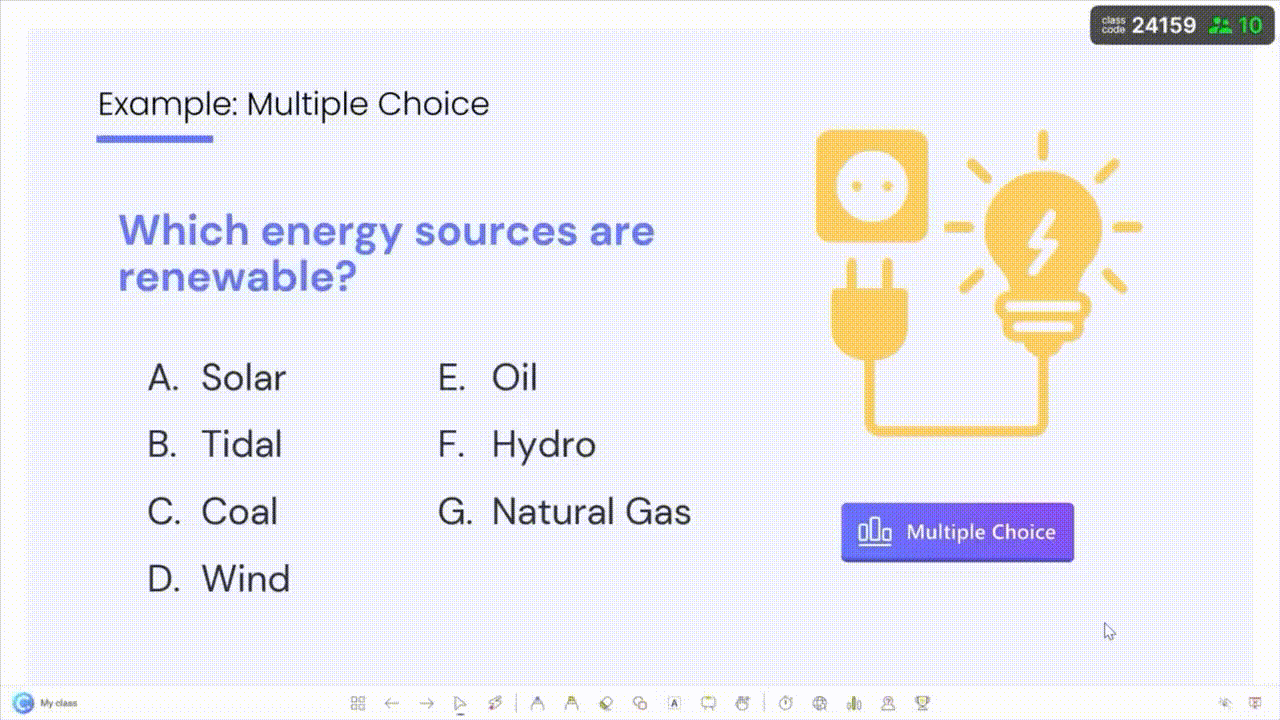Gen Z students learn in motion.
They are the first generation to grow up fully connected and fully aware of how technology shapes their choices. In higher education, they bring this fluency into every interaction, expecting classes to reflect the same immediacy and relevance they experience elsewhere.
They do not respond to tradition for its own sake. They value outcomes and clarity. They pay attention when learning feels purposeful and connected to their future.
For universities, this changes the rhythm of teaching. Classes that rely only on delivery struggle to hold attention. What works are environments that build interaction into every step. Tools that simplify participation and shorten the distance between teacher and student make a visible difference.
Understanding Gen Z students means recognizing that education now moves at their pace. The institutions that adapt will find sharper engagement and stronger learning results. Those that hesitate will fall behind a generation that learns by doing, not waiting.
Who Gen Z Students Are in Higher Education
Gen Z students, born between 1995 and 2012, now make up the majority of undergraduates across universities worldwide. They are the first generation to enter higher education with no memory of a world without smartphones, social media, or instant access to information.
Their outlook on college differs from earlier generations. In a recent survey, 83% of Gen Z respondents said a college education remains important, but many also question whether traditional systems are flexible enough to meet their needs. They weigh degrees against cost, time, and relevance to career outcomes rather than tradition or prestige.
What sets this generation apart in higher education today:
- They enroll with clear expectations for transparency and value.
- They seek education that feels aligned with future goals rather than fixed paths.
- They view technology as an essential part of how they learn and collaborate.
- They value inclusion and authenticity in how institutions communicate and teach.
Understanding this student group is the foundation for adapting instruction, and technology in today’s classrooms. These are the core areas we will be exploring in the next section.
Key Traits of Gen Z Students
It’s easy to misread Gen Z students. They’re often labelled as distracted or demanding when, in reality, they are discerning. They know what holds their attention and what doesn’t. They bring a level of self-awareness that challenges how teaching has traditionally worked.

To understand Gen Z students better, it helps to see what truly shapes their learning mindset:
- Purpose-Driven. They invest effort when learning feels anchored to something real. Abstract theory alone doesn’t hold them for long.
- Independent but Community-Oriented. They want space to explore ideas on their own but value environments that support open discussion and shared learning. Connection matters as much as autonomy.
- Digitally Fluent but Discerning. They use technology intuitively but can tell when it’s there for convenience versus genuine engagement. They notice when tools add noise instead of clarity.
- Direct About Expectations. They appreciate structure and feedback that are immediate and specific. They don’t wait quietly when something is unclear. Instead, they ask.
- Adaptive and Restless. They shift between devices, topics, and formats with ease. Repetition bores them.
- Equity-Minded. They notice representation in teaching styles. Fairness and inclusion influence how safe they feel to contribute.
- Selective With Attention. They are quick to disengage when learning feels one-way. But when something clicks, they stay present.
These traits point to a generation that approaches learning with intent. Gen Z students expect relevance, interaction, and respect for how they think. When teaching meets those expectations, engagement follows naturally.
Teaching Strategies That Engage Gen Z Learners
Teaching Gen Z students is a different kind of work. They arrive in higher education with clear expectations for how learning should feel. Below are practical strategies you can apply:
1. Design learning that mirrors real-world complexity
Gen Z students are not easily impressed by pre-packaged case studies or textbook scenarios. They live in a world that shifts fast and expect their education to reflect that same complexity. When a task feels overly neat or predictable, it signals that the classroom is disconnected from reality.
They are more invested when learning involves uncertainty, multiple perspectives, and space for judgment. The goal is to make learning content more authentic. Real-world problems rarely come with answer keys, and that’s what draws Gen Z learners in.
What to do instead:
- Use open-ended problems where information is partial or conflicting.
- Let students test competing solutions and justify their choices.
- Incorporate current data or live issues that evolve over the semester.
- Design group projects that mimic professional collaboration, not staged teamwork.
These experiences build cognitive resilience and prepare students for environments where answers require reasoning.
Check out our piece on Cooperative Learning 101: Key to Effective Student Teamwork.
2. Make participation intellectually useful, not performative
“Performative” gained traction in social media, used to call out gestures that look meaningful but lack substance. The same idea applies in teaching. Gen Z students can tell when participation is done for appearance. As a teacher, don’t be performative.
Participation should deepen thinking. Students engage when their ideas shape how class moves forward, not when interaction is used as filler.
What to replace → with:
- Icebreakers without connection → Guided discussion tied to a learning goal.
- Quick opinions → Evidence-based perspectives that can be challenged.
- Token “group work” → Structured collaboration with clear roles and accountability.
- Call-and-response questioning → Inquiry that pushes reasoning and synthesis.
Case in point: Gen Z students take participation seriously when it carries weight.
Here's a helpful guide on How to Increase Student Participation in the Classroom.
3. Treat technology as a professional language
For Gen Z students, technology is the very language of how work, research, and communication already happen outside school. They expect digital fluency from their professors as much as from their peers. When technology is used well, it signals credibility and awareness of the real world they are preparing to enter.
Start by choosing tools that match your teaching goals instead of adding more platforms for the sake of novelty. Explore tried and tested tools that help make learning more interactive, collaborative, and efficient:
- Synchronous Learning Tools to Power Live Classroom Lessons
- Classroom Technology Tools That Are Actually Worth Using
- Must-Have Interactive Presentation Tools for Engaging Classes
- Online Assessment Tools Teachers Actually Use in Real Classrooms
- Best Audience Response Systems for Classrooms
- Online Teaching Tools Every Educator Should Know
4. Give transparency the same weight as content
Gen Z students expect openness. They were raised in a world where information is shared instantly and where accountability is public.
In the classroom, that expectation translates to wanting to understand not just what they are learning but how and why.
If you use AI for planning lessons, let students know. If assessments rely on specific metrics, explain what they measure. If data is collected, clarify how it’s stored and used. The same goes for grading criteria, participation rules, attendance tracking, and digital platforms tied to performance.
When you are upfront about process, students read it as respect.
5. Balance autonomy with structured guidance
Gen Z students value independence but still look for clarity. They appreciate the freedom to make choices but want to know that those choices lead somewhere meaningful. The most effective teaching gives them space to explore within visible boundaries.
This balance can be difficult to strike. Too much freedom causes uncertainty. Too much control signals distrust. What works is structure that supports initiative.
| When there is too little guidance | When there is too much control | When balance is achieved |
|---|---|---|
| Students feel lost about expectations or grading. | Students comply but stop thinking independently. | Students know the goal but can choose how to reach it. |
| Group work drifts without progress. | Tasks are overly scripted and predictable. | Guidance frames objectives while allowing varied approaches. |
| Reflection or feedback happens too late. | Feedback is constant but prescriptive. | Feedback supports decision-making rather than replaces it. |
The goal is to create an environment where direction feels like support, not supervision. When students understand the frame, they use freedom well.
6. Show expertise through relevance, not authority
Gen Z students respect knowledge, but they test its currency. They pay attention to teachers who stay informed, who can connect theory to the present moment, and who model lifelong learning. Authority without relevance feels static to them.
Expertise today means showing how ideas evolve. It’s referencing recent research, discussing industry shifts, or linking content to what’s happening in the world right now.
Professors who share how they learn gain credibility quickly. It shows humility and confidence at once. For Gen Z students, relevance doesn’t dilute authority. It defines it.
To top it all off, here are 10-Game Changing Secrets to Boost Student Engagement in Higher Education.
How ClassPoint Supports Teaching Gen Z Students
Teaching Gen Z students often comes down to one consistent challenge: sustaining participation in a way that feels authentic.
In higher education, lectures and seminars still revolve around slides. This is where attention begins and, too often, fades. Instead of asking instructors to change platforms, ClassPoint enhances what they already use, turning existing presentations into live, collaborative sessions.
It supports the kind of immediacy and visibility that Gen Z students expect from digital environments.

Core functions that align with Gen Z learning preferences:
- Interactive quizzes for real-time responses – Keep attention active by turning slides into moments of participation where every student answers, not just the vocal few.
- Gamification with point scoring and leaderboards – Build healthy competition that motivates effort without losing focus on learning goals.
- Quick polls for instant feedback – Check comprehension or sentiment in seconds and adjust the discussion based on live insights.
- Name Picker for spontaneous contribution – Encourage equitable participation and make every student feel seen.
- Live annotation tools for dynamic slideshows – Highlight patterns, map ideas, and model thinking in real time.
ClassPoint fits the realities of higher education: time-limited sessions, diverse learners, and the need to make every moment count. It helps translate the strategies discussed earlier into visible practice.
